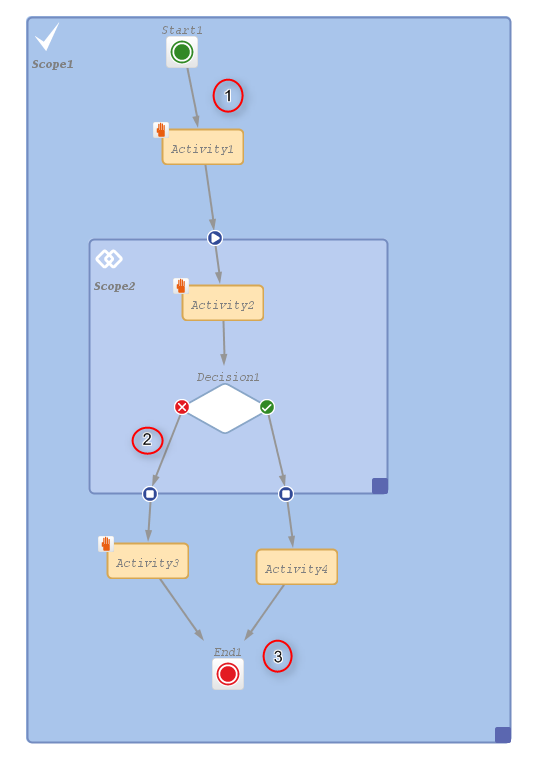Open topic with navigation
Process Logic
This chapter discusses the following:
Introduction
When you create and modify workflows it is important to know the basic principles of the workflow engine which result in the behavior of the ticket during the process. Therefore, we will give you a short overview of the basic rules of ConSol CM ticket processing.
Activities
Basic rules:
- Passing through a workflow, a ticket always waits behind the last activity, not before the next!
- Then it looks for the next activity which can be executed/passed.
- If the next possible activity is a manual activity, the ticket stays at the position behind the previous activity (number (1) and (2) in the following figure).
- If the next possible activity is an automatic activity, the activity is executed, i.e. the ticket passes through this activity (number (3) in the following figure).
- An activity can have one or more manual activities as successor activities or an activity can have (only) one automatic activity as successor activity.
- When you save a workflow, the Process Designer automatically executes a consistency check. If there are any inconsistencies (e.g. two automatic activities originating at the same predecessor activity), an error message is displayed and the workflow cannot be saved.
Figure 117: ConSol CM Process Designer - Process logic 1
Interrupts and Exceptions
In the course of a process, i.e. during the time when the ticket is open and engineers work on it, there might be events which have to be taken care of. For example, when an e-mail is received by the ticket or when a time range for an SLA has run out, it is important to register the event and to react accordingly.
There are two ways to define the reaction and behavior of the tickets. You can implement an ...
- interrupt
This is a workflow architecture where the event is registered, one or more automatic activities are executed, and the ticket returns to its previous position in the workflow.
- exception
This is a workflow architecture where the event is registered and, due to the following manual or automatic activities, the ticket leaves its previous position and is taken to a new position within the workflow or in another workflow.
Interrupts
Interrupts ...
- are activated by triggers.
- cause a short interruption of the process to react to the trigger event.
- use automatic activities (one or more subsequent automatic actions).
- put the ticket back to its previous position in the workflow, i.e. back to the position where it was when the interrupt event has fired.
- are often used to mark the ticket icon with an overlay, e.g. when an e-mail has been received (see figure below) or when an escalation time has been reached.
Figure 118: ConSol CM Process Designer - Two interrupts
Exceptions
Exceptions ...
- are activated by triggers.
- move the ticket from its old position in the workflow to a new position. The latter can be in the same or in another workflow.
- cause the process to continue at the new position.
Figure 119: ConSol CM Process Designer - Exception
Loops (Errors in Workflows)
(Infinite) Loops will cause errors in a process. They cannot be detected by the Process Designer, so you could deploy a workflow which contains a loop as shown in the figure below.
However, the process engine detects such loops at run-time and throws an InfiniteWorkflowLoopException to prevent the complete system failure. You can of course see the exception in the server.log file, where the name of the workflow and the activity which caused the error are also mentioned. In the Web Client, an error message is displayed.
Figure 120: ConSol CM Process Designer - Loop in workflow
Figure 121: ConSol CM Web Client - Error message when loop was detected
Figure 122: Console - File server.log: Error message caused by workflow loop
Business event triggers can also cause loops when the automatic activity which is attached to the trigger changes the parameter to which the trigger reacts. See section Avoid Self-Triggering Business Event Triggers.
Process Logic of Time Triggers
See section Business Logic and Initialization of a Time Trigger.
Process Logic of Business Event Triggers
See section Business Logic of Business Event Triggers .
